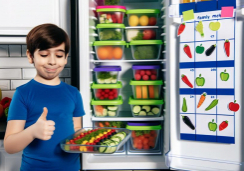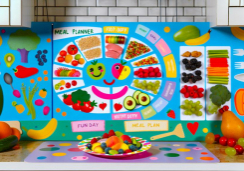What's on Your Diabetes-Friendly Meal Plan?
Have you ever wondered how to create a meal plan that not only satisfies your taste buds but also keeps your blood sugar levels in check? When living with diabetes, you're often told about foods to avoid, but let's shift the focus to what you can eagerly incorporate into your daily routine.
A diabetes-friendly meal plan doesn't have to be a dull affair; in fact, it can be quite the opposite. It's about balancing macronutrients, experimenting with low-glycemic foods, and understanding the impact of physical activity on your dietary needs.
As you consider the colorful array of foods that can adorn your plate—each chosen to support your health without sacrificing flavor—you might find yourself curious about the possibilities. Join us as we explore the nuances of crafting meals that are both nutritious and enjoyable, providing your body with the sustenance it needs while keeping your blood sugar levels stable.
Will you discover a new favorite dish, or perhaps a fresh take on an old classic? Let's find out together.
Understanding Carbohydrate Counting
To effectively manage your blood sugar levels, it's crucial to understand how the carbohydrates in your meals translate to glucose in your bloodstream. When you have diabetes, every bite matters, and carbohydrate counting becomes a key tool in your Diabetes Meal Plan.
Carbohydrates, found in foods like bread, fruit, and milk, are your body's main energy source but also the nutrient that most impacts your sugar levels. By keeping track of the carbs you consume, you're more equipped to manage blood sugar fluctuations.
The speed at which sugar enters your system isn't just about the carb content; it's also influenced by the type of food and its companions on your plate. Pairing carbs with fiber-rich non-starchy vegetables, whole grains, and lean protein can slow digestion and provide steadier blood sugar levels.
Working closely with a healthcare professional can help you determine your daily carb limits, ensuring your meal plans are tailored to your body's needs. Whether you're planning a meal or grabbing a snack, consider using the plate method—filling half your plate with non-starchy vegetables, a quarter with lean protein, and the remaining quarter with whole grains—to simplify carbohydrate counting and stabilize blood sugar.
Balancing Macronutrients
Balancing macronutrients is essential in creating a diabetes-friendly meal plan that supports stable blood sugar levels and overall health.
Here's a straightforward approach to ensure you're balancing macronutrients:
- Carbohydrates:
- Include a variety of fiber-rich sources like whole grains, legumes, and vegetables.
- Distribute your intake evenly across meals to help prevent blood sugar spikes.
- Use the plate method to control portions and focus on quality carbs.
- Protein:
- Aim to have a source of protein at each meal, which can include lean meats, fish, tofu, or legumes.
- Remember that protein is a stabilizing force for blood sugar levels.
- Consult with a registered dietitian to determine the right amount for your Diabetes Diet.
- Fats:
- Choose healthy fats, such as avocados, nuts, seeds, and olive oil.
- These fats can slow the absorption of carbohydrates, aiding in blood sugar management.
- Keep an eye on portion sizes, as fats are calorie-dense.
Incorporating Low-Glycemic Foods
While ensuring you're getting balanced macronutrients is crucial, it's equally important to select foods based on their glycemic impact to manage your diabetes effectively. Low-glycemic foods are key to controlling blood sugar levels and can be easily incorporated into your diabetes-friendly meal plan. These foods cause a slower, more gradual rise in blood sugar, making your meals and snacks work in your favor.
Start by filling half your plate with non-starchy vegetables that pack a nutritional punch without spiking your blood sugar. Think leafy greens, cucumbers, and bell peppers.
Next, choose fruits with care; a medium apple or a cup of fresh berries are excellent options that won't send your glucose levels soaring.
Whole grains like quinoa, barley, and whole-wheat bread provide sustained energy without the rapid blood sugar spike that refined grains can cause. These should be a staple in your diet.
For a satisfying snack, try some plain Greek yogurt with a handful of nuts—this combination of healthy fats and protein is ideal for blood sugar management.
Don't hesitate to consult with a registered dietitian to craft an easy-to-follow plan that incorporates these low-glycemic foods. They can help tailor your meals to your individual needs, ensuring a balanced approach to managing your diabetes.
Planning Around Physical Activity
Strategically timing your meals and snacks to align with your exercise regimen is crucial for maintaining optimal blood sugar levels and enhancing your physical performance. To keep your blood sugar steady and provide the energy you need, it's essential to plan carefully and make sure your Meal Plan for Weight management or general health includes the right balance of nutrients.
- Pre-Workout:
- Aim for a snack that includes about 15-30g carbohydrates and 10-15g protein to fuel your activity.
- Examples:
- A small apple with almond butter
- Greek yogurt with berries
- During Exercise:
- Keep it easy and light if you need something, especially during prolonged activity.
- Stay hydrated and monitor your blood sugar as needed.
- Examples:
- A few slices of turkey and cheese
- A handful of trail mix with nuts and dried fruit
- Post-Workout:
- Have a snack or meal that includes 15-20g protein and 30-45g carbohydrates to aid recovery.
- Make sure to include about 5-10g fiber for satiety and blood sugar control.
- Examples:
- Grilled chicken breast with quinoa and vegetables
- A protein shake with a banana and a spoonful of oat bran
Sample Diabetes-Friendly Recipes
Crafting a diabetes-friendly meal plan can be both enjoyable and simple, as evidenced by these flavorful recipes that cater to your nutritional needs and support blood sugar management.
Chipotle-Lime Cauliflower Taco Bowls can be a staple in your summer meal plan, offering a mix of zesty flavors and fiber-rich vegetables to help keep your blood sugar levels steady.
For those mornings when you're rushing out the door, Cinnamon-Roll Overnight Oats provide a quick, satisfying breakfast that aligns with your dietary goals.
When you're planning for a cozy dinner at home, a Slow-Cooker Vegetable Soup can be both comforting and easy to prepare, ensuring you have a nutrient-packed meal ready when you are.
If you're craving a sandwich, a Veggie & Hummus Sandwich isn't just a flavorful lunch option but also a smart choice to include in your meal plan.
For a heartier dinner, Lemon-Herb Salmon with Caponata & Farro brings together protein, whole grains, and antioxidants.
These diabetes-friendly recipes, possibly recommended by a registered dietitian like Seaver—who completed her undergraduate degree in dietetics and food science at the University of Vermont and a dietetic internship—can effortlessly fit into your meal plan.
Frequently Asked Questions
What Is Included in a Diabetic Meal Plan?
Your diabetic meal plan includes balancing carbohydrates, portion control, and choosing low glycemic index foods. Include fiber-rich foods, healthy fats, and prioritize hydration. Consider meal timing, smart snack selection, sugar substitutes, and cultural considerations.
What Is a Good Balanced Meal for a Diabetic?
A good balanced meal for you includes balancing macronutrients, focusing on fiber, and using the plate method for portion control. Consider the glycemic index, carb counting, and food pairing with healthy fats and sugar substitutes.
Can You Give Me a List of Food a Diabetic Can Eat?
You can eat nutrient-dense snacks, fiber-rich foods, and use sugar substitutes. Master carbohydrate counting, glycemic index charting, and portion control. Pair snacks wisely and stay hydrated. Listen to your body's satiety signals.
What Is a Good Meal to Serve a Diabetic Person?
You'll want a meal with lean protein, fiber-rich foods, and healthy fats. Consider the glycemic index, use sugar substitutes, and practice portion control. For dessert, opt for diabetic-friendly snacks and mind your meal timing.
Conclusion
You've now got the tools to craft a diabetes-friendly meal plan that suits your lifestyle. Remember, balancing carbs, proteins, and fats is key, and choosing low-glycemic foods can stabilize your blood sugar levels.
Adjust meals around your physical activities, and try out those sample recipes for nutritious twists on familiar favorites. Always consult with your healthcare team to personalize your diet.
Your health journey is unique—let's make sure your meal plan is too.










